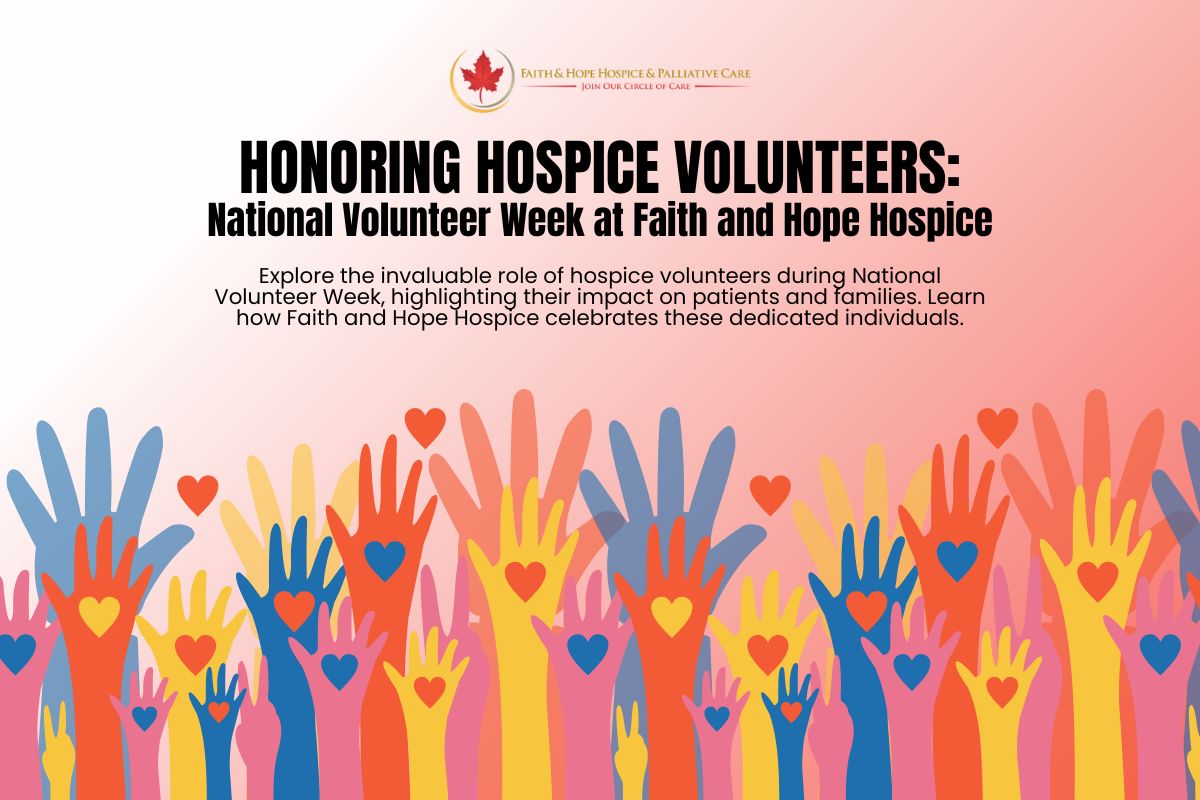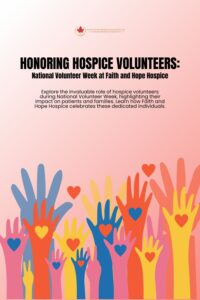
April 17-23 is National Volunteer Week, a time to recognize the selfless contributions of volunteers in hospice care. At Faith and Hope Hospice in Los Angeles, our volunteers are integral to providing compassionate support to patients and families.
Faith and Hope Hospice volunteers offer various services, including companionship, emotional support, running errands, and assisting with daily tasks. Their presence brings comfort and companionship to patients, alleviating loneliness and isolation. Volunteers also provide respite to caregivers, allowing them to take a break and recharge.

During National Volunteer Week, Faith and Hope Hospice celebrates the dedication and compassion of our volunteers. We honor their commitment to serving others and recognize the difference they make in the lives of our patients and families. Their kindness and generosity inspire us all to strive for a more compassionate world.
If you’re interested in volunteering at Faith and Hope Hospice, we invite you to join our team. Volunteers receive training and ongoing support to prepare for their role. Your time and compassion can make a meaningful difference in the lives of those facing end-of-life care.
There are numerous ways to volunteer with Faith and Hope Hospice. These include direct care, which may involve providing emotional support for the patient, family, and friends, as well as companionship, engaging in art activities, and more. Indirect care opportunities are also available, such as clerical work and assisting with fundraisers and community events.
Our agency provides an orientation that covers protocol, expectations, an overview of Los Angeles hospice, and an introduction to common hospice patient issues. We also offer ongoing educational opportunities yearly to ensure our volunteers are well-prepared.
Volunteers must be at least 18 years old to work directly with our patients. However, underage volunteers may assist with clerical tasks and community events, with a minimum age of 16 years.
No previous experience is necessary. We provide training and ongoing support to help you succeed in your role.
Volunteers must pass a background check, obtain CPR certification, and attend an orientation that covers the hospice philosophy, working within an interdisciplinary team, and documentation for visits.
The Volunteer Coordinator assigns patients to volunteers based on similar interests, location, and the number of patients a volunteer wishes to work with.
After being assigned the patient of faith and Hope, the Volunteer Coordinator will instruct the volunteer on who to contact to schedule a visit. Volunteers may reach out via phone to determine the best time to visit.
The Volunteer Coordinator determines the frequency of volunteer visits based on the needs and desires of the patient, family, and friends. The frequency is reassessed at every recertification period.
We provide mileage reimbursement to volunteers who use their vehicles to visit their assigned patients.
Read more about it here: https://faithandhopehospice.com/volunteer-program/
National Volunteer Week is a time to honor and celebrate the invaluable contributions of hospice volunteers. At Faith and Hope Hospice in Los Angeles, our volunteers are crucial to our care team, providing comfort, companionship, and support to our patients and families. Join us in recognizing and thanking our volunteers for their dedication and compassion during this special week.
Faith and Hope Hospice
We firmly believe that the internet should be available and accessible to anyone, and are committed to providing a website that is accessible to the widest possible audience, regardless of circumstance and ability.
To fulfill this, we aim to adhere as strictly as possible to the World Wide Web Consortium’s (W3C) Web Content Accessibility Guidelines 2.1 (WCAG 2.1) at the AA level. These guidelines explain how to make web content accessible to people with a wide array of disabilities. Complying with those guidelines helps us ensure that the website is accessible to all people: blind people, people with motor impairments, visual impairment, cognitive disabilities, and more.
This website utilizes various technologies that are meant to make it as accessible as possible at all times. We utilize an accessibility interface that allows persons with specific disabilities to adjust the website’s UI (user interface) and design it to their personal needs.
Additionally, the website utilizes an AI-based application that runs in the background and optimizes its accessibility level constantly. This application remediates the website’s HTML, adapts Its functionality and behavior for screen-readers used by the blind users, and for keyboard functions used by individuals with motor impairments.
If you’ve found a malfunction or have ideas for improvement, we’ll be happy to hear from you. You can reach out to the website’s operators by using the following email
Our website implements the ARIA attributes (Accessible Rich Internet Applications) technique, alongside various different behavioral changes, to ensure blind users visiting with screen-readers are able to read, comprehend, and enjoy the website’s functions. As soon as a user with a screen-reader enters your site, they immediately receive a prompt to enter the Screen-Reader Profile so they can browse and operate your site effectively. Here’s how our website covers some of the most important screen-reader requirements, alongside console screenshots of code examples:
Screen-reader optimization: we run a background process that learns the website’s components from top to bottom, to ensure ongoing compliance even when updating the website. In this process, we provide screen-readers with meaningful data using the ARIA set of attributes. For example, we provide accurate form labels; descriptions for actionable icons (social media icons, search icons, cart icons, etc.); validation guidance for form inputs; element roles such as buttons, menus, modal dialogues (popups), and others. Additionally, the background process scans all the website’s images and provides an accurate and meaningful image-object-recognition-based description as an ALT (alternate text) tag for images that are not described. It will also extract texts that are embedded within the image, using an OCR (optical character recognition) technology. To turn on screen-reader adjustments at any time, users need only to press the Alt+1 keyboard combination. Screen-reader users also get automatic announcements to turn the Screen-reader mode on as soon as they enter the website.
These adjustments are compatible with all popular screen readers, including JAWS and NVDA.
Keyboard navigation optimization: The background process also adjusts the website’s HTML, and adds various behaviors using JavaScript code to make the website operable by the keyboard. This includes the ability to navigate the website using the Tab and Shift+Tab keys, operate dropdowns with the arrow keys, close them with Esc, trigger buttons and links using the Enter key, navigate between radio and checkbox elements using the arrow keys, and fill them in with the Spacebar or Enter key.Additionally, keyboard users will find quick-navigation and content-skip menus, available at any time by clicking Alt+1, or as the first elements of the site while navigating with the keyboard. The background process also handles triggered popups by moving the keyboard focus towards them as soon as they appear, and not allow the focus drift outside it.
Users can also use shortcuts such as “M” (menus), “H” (headings), “F” (forms), “B” (buttons), and “G” (graphics) to jump to specific elements.
We aim to support the widest array of browsers and assistive technologies as possible, so our users can choose the best fitting tools for them, with as few limitations as possible. Therefore, we have worked very hard to be able to support all major systems that comprise over 95% of the user market share including Google Chrome, Mozilla Firefox, Apple Safari, Opera and Microsoft Edge, JAWS and NVDA (screen readers).
Despite our very best efforts to allow anybody to adjust the website to their needs. There may still be pages or sections that are not fully accessible, are in the process of becoming accessible, or are lacking an adequate technological solution to make them accessible. Still, we are continually improving our accessibility, adding, updating and improving its options and features, and developing and adopting new technologies. All this is meant to reach the optimal level of accessibility, following technological advancements. For any assistance, please reach out to
